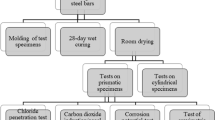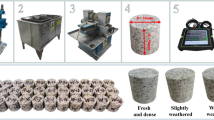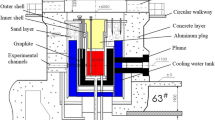Abstract
Objective
Compact medical cyclotrons have been set up to generate the nuclides necessary for positron emission tomography. In accelerator facilities, neutrons activate the concrete used to construct the vault room; this activation increases with the use of an accelerator. The activation causes a substantial radioactive waste management problem when facilities are decommissioned. In the present study, several concrete cores from the walls, ceiling and floor of a compact medical cyclotron vault room were samples 2 years after the termination of operations, and the radioactivity concentrations of radionuclides were estimated.
Methods
Cylindrical concrete cores 5 cm in diameter and 10 cm in length were bored from the concrete wall, ceiling and floor. Core boring was performed at 18 points. The gamma-ray spectrum of each sample was measured using a high-purity germanium detector. The degree of activation of the concrete in the cyclotron vault room was analyzed, and the range and tendency toward activation in the vault room were examined.
Results
60Co and 152Eu were identified by gamma-ray spectrometry of the concrete samples. 152Eu and 60Co are produced principally from the stable isotopes of europium and cobalt by neutron capture reactions. The radioactivity concentration did not vary much between the surface of the concrete and at a depth of 10 cm. Although the radioactivity concentration near the target was higher than the clearance level for radioactive waste indicated in IAEA RS-G-1.7, the mean radioactivity concentration in the walls and floor was lower than the clearance level.
Conclusion
The radioactivity concentration of the inner concrete wall of the medical cyclotron vault room was not uniform. The areas exceeding the clearance level were in the vicinity of the target, but most of the building did not exceed the clearance levels.





Similar content being viewed by others
References
International Atomic Energy Agency. Decommission of small medical, industrial and research facilities. Technical Reports Series No. 44. IAEA (2003).
Phillips AB, Prull DE, Ristinen RA, Kraushaar JJ. Residual radioactivity in a cyclotron and its surroundings. Health Phys. 1986;51:337–42.
Kimura K, Ishikawa T, Kinno M, Yamadera A, Nakamura T. Residual long-lived radioactivity distribution in the inner concrete wall of a cyclotron vault. Health Phys. 1994;67:62131.
Masumoto K, Toyoda A, Eda K, Izumi Y, Shibata T. Evaluation of radioactivity induced in the accelerator building and its application to decontamination work. J Radioanal Nucl Chem. 2003;255:465–9.
Saito K, Tanosaki T, Fujii H, Miura T. Analysis of induced radionuclides in low-activation concrete (limestone concrete) using the 12 GeV proton synchrotron accelerator facility at KEK. Radiat Prot Dosim. 2005;116:647–52.
Numajiri M. Evaluation of the radioactivity of the pre-dominant gamma emitters in components used at high-energy proton accelerator facilities. Radiat Prot Dosim. 2007;123:417–25.
Yamaguchi I, Kimura K, Fujibuchi T, Takahashi Y, Saito K, Otake H. Radiation safety management of residual long-lived radioactivity distributed in an inner concrete wall of a medical cyclotron room. Radiat Prot Dosim. 2011;146:167–9.
Martínez-Serrano JJ, Ríos AD. Prediction of neutron induced radioactivity in the concrete walls of a PET cyclotron vault room with MCNPX. Med Phys. 2010;37:6015–21.
International Atomic Energy Agency. Application of the concepts of exclusion, exemption and clearance. Safety guide No. RS-G-1.7. IAEA (2004).
Fujibuchi T, Yamaguchi I, Watanabe H, Kimura K, Tanaka S, Kida T, et al. Nationwide survey on the operational status of medical compact cyclotrons in Japan. Radiol Phys Technol. 2009;2:126–32.
Fujibuchi T, Yamaguchi I, Kasahara T, Iimori T, Masuda Y, Kimura K, et al. Measurement of thermal neutron fluence distribution with use of 23Na radioactivation around a medical compact cyclotron. Radiol Phys Technol. 2009;2:159–65.
Radioisotope Pocket Data Book 11th Edition, The Japan Radioisotope Association; 2011.
Suzuki A, Iida T, Moriizumi J, Sakuma Y, Takada J, Yamasaki K, Yoshimoto T. Trace element with large activation cross section in concrete materials in Japan. J Nucl Sci Technol. 2001;38:542–50.
Kinno M, Kimura K, Nakamura T. Raw materials for low-activation concrete neutron shields. J Nucl Sci Technol. 2002;39:1275–80.
Carroll LR. Predicting long-lived, neutron-induced activation of concrete in a cyclotron vault. AIP Conf Proc. 2001;576:301–4.
Evans JC, Lepel EL, Sanders RW, Wilkerson CL, Silker W, Thomas CW, et al. Long-lived activation products in reactor materials. NUREG/CR-3474; 1984.
Vega-Carrillo HR. Neutron energy spectra inside a PET cyclotron vault room. Nucl Instr Methods A. 2001;463:375–86.
Fernandez F, Amgarou K, Domingo C, Garcia MJ, Quincoces G, Marti-Climent JM, et al. Neutron spectrometry in a PET cyclotron with a Bonner sphere system. Radiat Prot Dosim. 2005;126:371–5.
Mendez R, Iniguez MP, Martí-Climent JM, Penuelas I, Vega-Carrillo HR, Barquero R. Study of the neutron field in the vicinity of an unshielded PET cyclotron. Phys Med Biol. 2005;50:5141–52.
Gallerani R, Cicoria G, Fantuzzi E, Marengo M, Mostacci D. Neutron production in the operation of a 16.5 MeV PETrace cyclotron. Prog Nucl Energy. 2008;50:939–43.
Kaur A, Sharma S, Mittal BR. Radiation surveillance in and around cyclotron facility. Indian J Nucl Med. 2012;27:243–5.
Tochon-Danguy H, Sachinidis JI, U P, Egan G, Mukherjee B. Occupational radiation exposure at the self-shielded IBA Cyclone 10/5 Cyclotron of the A&R MC, Melbourne, Australia. In: Proceedings of the 15th international conference on cyclotrons and their applications. 1998; p. 105–7.
Stevenson NR. Future cyclotron systems: an industrial perspective. In: Proceedings of the 14th international conference on cyclotrons and their applications. 1995; p. 581–4.
Ogata Y, Ishigure N, Mochizuki S, Ito K, Hatano K, Abe J, et al. Distribution of thermal neutron flux around a PET cyclotron. Health Phys. 2011;100:S60–6.
Author information
Authors and Affiliations
Corresponding author
Rights and permissions
About this article
Cite this article
Fujibuchi, T., Nohtomi, A., Baba, S. et al. Distribution of residual long-lived radioactivity in the inner concrete walls of a compact medical cyclotron vault room. Ann Nucl Med 29, 84–90 (2015). https://doi.org/10.1007/s12149-014-0918-6
Received:
Accepted:
Published:
Issue Date:
DOI: https://doi.org/10.1007/s12149-014-0918-6




